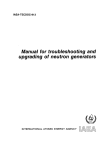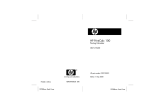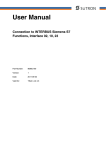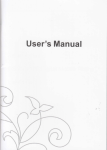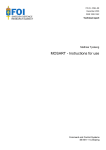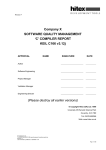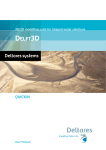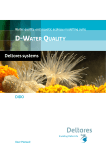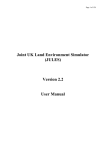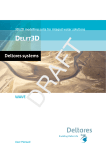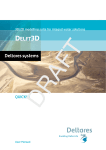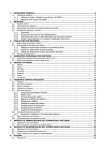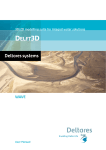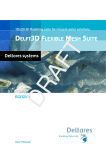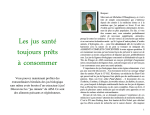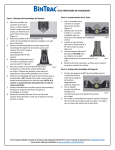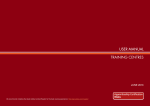Download MOSART Installation Manual
Transcript
MOSART-NRL-DOC-IRM-001-v2.0-110222 Moderate Spectral Atmospheric Radiance and Transmittance Code MOSART v2.0 Volume I: Installation Reference Manual 22 February 2011 U.S. Naval Research Laboratory Space Science Division 4555 Overlook Ave., SW Washington, DC 20375 Distribution A: Approved for public release; distribution is unlimited. Prepared for the Naval Research Laboratory by: William M. Cornette and William H. Duff Computational Physics, Inc. Springfield, VA Jules M. Goldspiel Naval Research Laboratory Washington, DC ii Table of Contents 1 Introduction............................................................................................................................... 1 2 Delivery Format and Hardware Requirements ......................................................................... 1 3 Installing the MOSART Code and Utilities.............................................................................. 1 3.1 Setting Directory Paths ...................................................................................................... 2 3.2 Executing Floating-point Test: FPTEST............................................................................ 3 3.3 Installing Data bases: INSTDB .......................................................................................... 3 3.4 Testing MOSART Execution ............................................................................................. 5 3.5 Cleaning-up ........................................................................................................................ 5 4 Other Utilities ........................................................................................................................... 5 Appendix A: Input Test File ........................................................................................................... 6 Appendix B: FPTEST Output ......................................................................................................... 7 iii 1 Introduction The Moderate Spectral Atmospheric Radiance and Transfer (MOSART) computer program calculates atmospheric transmission and radiation from the ultraviolet through the microwave spectral regions (wavenumbers of 0 - 50,000 cm-1 or wavelengths of 0.2 μm to infinity). This volume of the User's Manual describes the installation of the various model elements used in MOSART. The other volume in the User's Manual describes how to run the code (Vol. II: User Reference Manual). In addition to the main MOSART code, a set of utility codes is also included in this distribution. The utility codes delivered with MOSART include: ASCBIN: Converts binary files to ASCII and vice-versa BBTEMP: Converts radiance to equivalent blackbody temperatures CRFILE: Assists in preparing the MOSART input file FPTEST: Tests machine dependent operations INSTDB: Installs direct access binary data bases MRFLTR: Degrades the spectral output using a filter function TERTEM: Calculates diurnal terrain material temperatures VISUAL: Converts visible radiance to luminance and determines color 2 Delivery Format and Hardware Requirements MOSART v2.0 is supplied on a CD-ROM, which includes the executable codes of MOSART and associated utilities, ASCII versions of various data bases, and a number of files that the user may find useful. The MOSART code and utilities, as provided on the CD-ROM, require approximately 350 MB of disk space. During installation, additional disk space (up to another 200 MB) may be required for such things as installing the data bases and running test cases. At present, only the Red Hat Enterprise Linux® 5 operating system is actively supported. Other versions of Linux may work, but all Linux versions have not been tested. Versions of MOSART for Windows, Mac OS X, and other versions of Unix may be available upon special request. Contact MOSART User Support for more information ([email protected]). 3 Installing the MOSART Code and Utilities To install MOSART and the associated data bases and utilities, first copy the files from the CD to a directory of your choosing. The directory structure on the CD should be retained on your computer. Once MOSART is properly installed, the executable can be placed and executed from anywhere on the computer. However, to insure that the executables and data bases are found during run time, it is necessary to define the paths (directories) for the newly installed MOSART codes and data bases. Instructions on how to define the MOSART paths are provided in Section 3.1 below. Instructions for completing the remaining installation steps and for running installation tests are provided in Sections 3.2 – 3.5. 1 3.1 Setting Directory Paths The data bases used by MOSART (the molecular data bases, the global scene/altitude data base, the global climatology data base, the global atmospheric profile data bases, the global hydrology data base, and the SAG/NRL data bases) are installed with a default directory path. To insure that MOSART can access all necessary files, the MOSART directory path should be reset for each installation. The path for the new installation is specified by the Unix/Linux set environment command setenv (or export for bash). It is strongly recommended that the directory path be as global as possible to permit the MOSART program to be executed from anywhere in the computer directory system. Accordingly, the recommended method for setting the data base directory path is to place the path definition in the .cshrc file (or other appropriate file). For csh and related shells, the path may be defined by: setenv MOSART_DBPATH <data_base_directory> For bash, the equivalent definition is: export MOSART_DBPATH =<data_base_directory> where <data_base_directory> is the full path to the Data directory in the directory structure copied from the CD-ROM. NOTE: The MOSART_DBPATH environment variable must be set in the .cshrc (or other appropriate file) for each user who intends to run MOSART. If placing the setenv (or export for bash) command in the .cshrc file (or other appropriate file) is not possible or convenient, the setenv (or export for bash) command must be executed just before the command to execute MOSART (and INSTDB during the installation of the data bases as discussed in Section 3.3). If there is no entry in .cshrc for MOSART_DBPATH and setenv command is not executed prior to the execution of MOSART, then the default value that is hard-wired in the code is used, which is a directory path that may or may not exist on the host computer. Contact MOSART User Support for more information ([email protected]). Although not required, users may find it convenient to also define a path to the executables for MOSART and related utilities. This will allow MOSART to be easily executed from any directory that contains formatted MOSART input files. For example, the path to the MOSART executable may be defined for csh and related shells, and then added to the user’s path by including the following lines in the .cshrc (or equivalent) file: setenv MOSART_TOP <executables_directory> set path=($path $MOSART_TOP) For bash, the equivalent definitions are: export MOSART_TOP =<executables_directory> export path=$path:$MOSART_TOP where <executables_directory> is the full path to the MOSART executable directory. 2 3.2 Executing Floating-point Test: FPTEST The MOSART code is delivered with a floating-point test code that determines a number of capabilities of the computer and operating system. It is strongly recommended that FPTEST is the first code to be executed. The output from FPTEST will be automatically sent to the file fptest.log. This file should be retained and used if numerical debugging is necessary. The output from the FPTEST utility is useful in debugging certain problems a user may encounter with the MOSART code. This information should be provided, together with sample *.in, *.out, and *.log files (and a screen dump, if appropriate), with any questions concerning a problem encountered with MOSART or its utilities. To execute FPTEST, simply enter ./fptest on the command line. A sample fptest.log is shown in Appendix B for a Linux computer using a MOSART executable compiled with the gfortran compiler. 3.3 Installing Data bases: INSTDB The second code that should be executed is the utility that installs the binary direct access data bases, INSTDB. The MOSART v2.0 code uses six (6) direct access binary data bases that require installation from ASCII files. These data bases include: • Molecular Band Model Parameters • Global Climatology Data Base • Global Ecosystems/Scene Background Data Base • Global Climatology Profile Data Base (new) • Global Hydrology Data Base (snow cover, ice cover, ice temperature) • Global Oceanic Data Base (sea surface temperature and salinity MOSART v2.0 code can operate with different sets of molecular data bases: • The UFTAPE data base used (and installed with) MODTRAN 3.7, or • Any combination of MOSART data bases and the UFTAPE data base. However, if the MOSART code cannot find any of the MOSART data base files, it uses default values (e.g., sea level altitude, ocean background, model atmosphere, surface air temperature, no cloud cover). The MOSART v2.0 code is designed to automatically determine the required record length for each binary direct access data file. The data base installation code, INSTDB, is fully automated. To execute INSTDB, simply enter ./instdb on the command line (after defining the data base directory path MOSART_DBPATH as discussed in Section 3.1 above). Due to the size of the data bases being installed, this may take a few minutes. Output from INSTDB is written to the file instdb.log. An example of instdb.log file is below (note that a full path name is provided for each file name in the instdb.log file): Conversion completed for MOLBMP96 Molecular The file properties are: Number of records = 154209 Check sum = 31463097 Existence = T OPENed = T 3 Access type Format type Record length Device number File name Action allowed = = = = = = DIRECT UNFORMATTED 60 62 /home/work/Data/cornette/Data/UFTAPE3.5A READWRITE Conversion completed for Global Climatology The file properties are: Number of records = 24840 Check sum = 7155602 Existence = T OPENed = T Access type = DIRECT Format type = UNFORMATTED Record length = 156 Device number = 32 File name = /home/work/Data/cornette/Data/global.dat Action allowed = READWRITE Conversion completed for Scene Background The file properties are: Number of records = 64800 Check sum = 783011 Existence = T OPENed = T Access type = DIRECT Format type = UNFORMATTED Record length = 216 Device number = 36 File name = /home/work/Data/cornette/Data/ecosys.dat Action allowed = READWRITE Conversion completed for Hydrology (Water/Snow/Ice/SST) The file properties are: Number of records = 64800 Check sum = 6246849 Existence = T OPENed = T Access type = DIRECT Format type = UNFORMATTED Record length = 152 Device number = 33 File name = /home/work/Data/cornette/Data/hydro.dat Action allowed = READWRITE Conversion completed for Oceanic (Sea Temp and Salinity) The file properties are: Number of records = 1036800 Check sum = 9198245 Existence = T OPENed = T Access type = DIRECT Format type = UNFORMATTED Record length = 104 Device number = 34 File name = /home/work/Data/cornette/Data/sstsss.dat Action allowed = READWRITE Conversion completed for Atmospheric Profile The file properties are: Number of records = 2664 Check sum = 41448 Existence = T OPENed = T Access type = DIRECT Format type = UNFORMATTED Record length = 2776 Device number = 35 File name = /home/work/Data/cornette/Data/profile.dat Action allowed = READWRITE 4 3.4 Testing MOSART Execution A test input file, test.in, is supplied with the MOSART software and it is installed in folder test/ along with a number of other test files. The file test.in is listed in Appendix A. For comparison, test outputs are contained in the folder test/out for all the test cases. This test program (test.in) requires approximately 1-2 seconds of CPU time for a typical computer. The code should be executed by inputting from within the /test directory: ./mosart test Note that user provides only the file root (e.g., test), and MOSART will append the appropriate file type suffixes, e.g., test.in, test.out, test.log. If the execution test is successful, the following information should be output to the terminal (or device '*'): STOP Normal Termination Additional summary information is output to test.log along with any warning messages. Some of the features may differ slightly between different types of computers (e.g., the STOP statement), but the numerical results should be essentially the same for each platform. 3.5 Cleaning-up During the above installation procedures, a number of files were created that are not required after installation. The executables FPTEST and INSTDB can be deleted, and the ASCII data files (located in Data/ASCII/) can be compressed, or if it is necessary to save space, these ASCII data files can be deleted. However, do NOT delete or compress the files in Data/ASCII/NRLDAT and do NOT delete fptest.log. 4 Other Utilities In addition to the MOSART code and the installation utilities FPTEST and INSTDB, the following utilities are included and installed with the MOSART distribution: ASCBIN: ASCII-Binary Conversion BBTEMP: Blackbody Temperature Converter CRFILE: Input File Creator MRFLTR: MOSART Filter Code TERTEM: Terrain Temperature Calculator VISUAL: Visual (Luminance) Converter Information on using these utilities is provided in the MOSART User Reference Manual. 5 Appendix A: Input Test File The following is the MOSART v2.0 input file test.in that is used for the MOSART execution test (see Section 3). The corresponding output and log files are test.out, and test.log, respectively. Moderate Spectral Atmospheric Radiance and Transmittance (MOSART) (Ver. 2.0) . User-specified Parameters ---------------------------------Header ................................ Test Case No. 1 Printout Switch (S/M/L) ............... Large Delete Existing Files (Y/N) ........... Yes Terrain Temperature Calcul. (Y/N) ..... No Multiple Scattering Calcul. (Y/N) ..... No ExpSumFit Method (None/Wisc/Malk) ... Malkmus/Laguerre No. of Terms (1-10,12,15) ........... 4 Solar/Lunar Ephemeris (Y/S/L/N) ....... No Exoatmospheric Solar Data ............. newkur Analytic Phase Function (CS/HG) ....... CS Analytic earth/skyshine model (Y/N) ... No Climatology (Temp/Humidity/Wind) ...... None None None . Position Parameters ---------------------------------------Coordinate Reference (Obsvr/Source) ... Source Latitude (deg) (+ North, - South) ..... 50:00:00.0 Longitude (deg) (+ East, - West) ...... -100:00:00.0 Day of the month (integer) ............ 21 Month of the year (integer) ........... June Year (integer) ........................ 1991 Time of day (24-hr HH.MMSS/HH:MM:SS) .. 12:00:00.0 Time zone ............................. LST . Geometry Parameters ---------------------------------------Observer Azimuths (deg) (<=8) ......... 0. 90. 180. 270. Azimuth Reference (Relative/True) ..... True . No. Index Obs. Alt. Sr/Tn.Alt. Sl.Rng. Earth Ang. Obs.Angle Src. Angle Length (km) (km) (km) (deg) (deg.) (deg.) Switch 1 Se 100.0 1.0 ***** ***** ***** 1.0 0 2 Be 100.0 ***** ***** ***** ***** 90.0 0 3 Ce 100.0 1.0 ***** ***** -90.0 ***** 0 4 Ce 100.0 ***** 120.0 ***** -6.0 ***** 0 5 Cz 100.0 1.0 ***** 0.0 ***** ***** 0 6 Cl 100.0 1.0 ***** ***** 46:00 -98:12 * 7 Ae 1.0 ***** ***** ***** ***** ***** * 8 He 1.0 ***** 1.0 ***** ***** ***** * 9 Le 400.0 ***** ***** ***** -7.0 ***** * 10 Le 100.0 1.0 ***** ***** ***** ***** * 11 Le 400.0 -200. ***** ***** ***** ***** * 12 Le 400.0 ***** ***** ***** -19.75 ***** * End of Geometry Data/ . Spectral Parameters ---------------------------------------Spectral Calculations (MO/MM) ......... MO Wavenumber or Wavelength (WN/WL/FR) ... WN Initial wavenumber (cm**-1/um/GHz) .. 3000. Final wavenumber (cm**-1/um/GHz) .... 3000. . . 6 Appendix B: FPTEST Output Sample FPTEST outputs from a Linux computer using a MOSART executable compiled with the gfortran 4.1-2 compiler on a Linux operating system. MOSART Radiative Environment Summary (Ver. 2.00c) Floating Point Number Test 27 Apr 2010 09:25:39 Radix = 2 Number of bits in INTEGER = 32 Little-endian representation Floating-point addition with IEEE rounding Gradual underflow Two's complement representation Register and storage calculations have different precisions No. of guard digits = 0 Precision No. of bits in significand No. of bits in exponent Smallest exponent for 1+e Smallest exponent for 1-e Maximum exponent Minimum exponent Pi (3.1415926535897932384626) e (2.7182818284590452353603) Logarithm (base 10) of radix Large Positive number Largest relative spacing Smallest relative spacing Smallest normalized number Smallest denormalized number Positive Infinity Negative Infinity Positive Signaling NaN Negative Signaling NaN Positive Quiet NaN Negative Quiet NaN Positive Zero Negative Zero = = = = = = = = = = = = = = = = = = = = = = = ---- REAL ---- ---- DOUBLE PRECISION ---- ---- INTEGER ---6 15 24 53 31 8 11 -23 -52 -24 -53 128 1024 -125 -1021 3.141592741 3.14159265358979312 2.718281746 2.71828182845904509 0.301030010 0.30102999566398120 3.402823466E+38 1.79769313486231571E+308 2147483647 1.192092896E-07 2.22044604925031308E-016 5.960464478E-08 1.11022302462515654E-016 1.175494351E-38 2.22507385850720138E-308 0.000000000E+00 0.00000000000000000E+000 +Infinity +Infinity -Infinity -Infinity NaN NaN NaN NaN NaN NaN NaN NaN 0.000000000E+00 0.00000000000000000E+000 0.000000000E+00 0.00000000000000000E+000 It appears that this computer complies with IEEE Standard 754. All file handling assumes that only the latest version of a file is saved. This computer does not initialize variables. This computer MAY operate in static mode. 7










